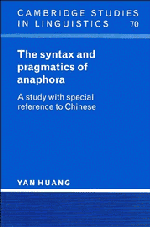Book contents
- Frontmatter
- Contents
- Preface
- Abbreviations used in glosses
- 1 A neo-Gricean pragmatic theory and anaphora
- PART I ANAPHORA IN GOVERNMENT AND BINDING THEORY
- PART II THE PRAGMATICS OF ANAPHORA
- 5 A neo-Gricean pragmatic theory of anaphora
- 6 Further applications of the theory
- 7 Anaphoric production in conversation
- 8 Anaphoric resolution in conversation
- 9 Conclusions
- Notes
- References
- Index of names
- Index of languages
- Index of subjects
6 - Further applications of the theory
Published online by Cambridge University Press: 23 October 2009
- Frontmatter
- Contents
- Preface
- Abbreviations used in glosses
- 1 A neo-Gricean pragmatic theory and anaphora
- PART I ANAPHORA IN GOVERNMENT AND BINDING THEORY
- PART II THE PRAGMATICS OF ANAPHORA
- 5 A neo-Gricean pragmatic theory of anaphora
- 6 Further applications of the theory
- 7 Anaphoric production in conversation
- 8 Anaphoric resolution in conversation
- 9 Conclusions
- Notes
- References
- Index of names
- Index of languages
- Index of subjects
Summary
Introduction
In the last chapter, I developed a neo-Gricean pragmatic theory of anaphora. In this theory, we assume that there is a distinction of referential dependence between reflexives on the one hand, and other types of anaphoric expression on the other, and we attribute this difference to semantics. The interpretation of zero anaphors, pronouns, reflexives and lexical NPs can then be largely reduced to the systematic interplay of two neo-Gricean pragmatic principles, namely the M- and I-principles (with that order of preference), counterbalanced by the DRP, information saliency and general consistency conditions on conversational implicatures. Such a pragmatic theory, of course, does not deny the existence of distinct syntactic, semantic and pragmatic levels and modes of explanation in the study of anaphora. On the contrary, it presumes the independence, or at least partial independence, of an irreducible grammaticalised stratum for pragmatically motivated constraints on anaphora. What pragmatics does here is to provide a set of complementary, explanatory principles which constrains the interpretation or production of an anaphoric expression whose linguistic representation has already been antecedently cognised. However, these are important and indispensable principles for any adequate theory of anaphora, for as we already saw in the last chapter, they can effect substantial simplifications in the syntax of anaphora.
In this chapter, I shall put the theory on further testing against more data from Chinese. I shall begin with zero anaphors. I shall look at zero anaphors in the control construction in section 6.2, in the topic construction in section 6.3 and in the relative construction in section 6.4. Section 6.5 then considers the zero anaphor/overt pronoun contrast, arguing that Chomsky's (1981) ‘Avoid Pronoun’ Principle follows directly from the interaction of the I- and M-principles.
- Type
- Chapter
- Information
- The Syntax and Pragmatics of AnaphoraA Study with Special Reference to Chinese, pp. 148 - 203Publisher: Cambridge University PressPrint publication year: 1994



